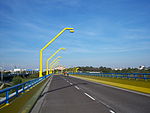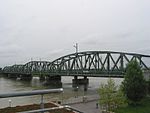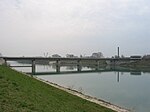Vienna bridges over the Danube

The Vienna Danube bridges connect the old part of Vienna on the right bank of the Danube with the younger districts on the left bank.
General
Only those bridges that cross the Danube and the New Danube and thus establish connections between the urban area south (right bank) and north (left bank) of the Danube are of supra-local importance. There are currently ten bridges over both branches of the river, five of which are road, two rail and two underground bridges, one footbridge is reserved for pedestrians and cyclists. At one of the road bridges, the Reichsbrücke, there are underground tracks in the basement.
In the southeast of the city there are two pipe bridges that connect pipelines on the left bank of Vienna and right bank of Lower Austria.
Seven other bridges, including weirs 1 and 2, lead in Vienna from the northern (left bank) bank of the Danube over the New Danube to the Danube Island and serve to develop it locally. The inlet structure of the New Danube is located in Lower Austria.
The Freudenau power plant in the main stream, together with the Walulisobrücke over the New Danube, represents a transition for pedestrians and cyclists over both arms of the river.
history
The once unregulated Danube was a heavily branched river within the current city limits of Vienna. Before the first bridges were built - and in some cases afterwards - you had to rely on ferry boats to cross one or more branches of the Danube , the so-called Urfahre , which could be used for a fee. In the middle of the 15th century, the construction of fortified Danube bridges in the Vienna area began as a result of the bridging rights issued by King Albrecht II . In 1439 the Wolfsbrücke was built, a wooden bridge in the area of today's Floridsdorfer Brücke . This was followed by the long bridge near the Augarten and the striking bridge in the area of today's Schwedenbrücke , which was mentioned in a document in 1464. The striking bridge owes its name to the fact that - coming from the direction of Floridsdorf - it was the last bridge to be crossed before Vienna, where slaughtered cattle were "beaten" (i.e. slaughtered), as hygiene regulations forbade the long transport of dead cattle or meat.
These and a few other bridges were guarded by mercenaries and could only be passed by paying a bridge toll , which in turn was used for repair and maintenance work, as the bridges were repeatedly damaged or made impassable by floods and ice jams . In 1698 a first attempt was finally made to regulate the Danube in the area of Vienna. The Wolfsbrücke was demolished and the Great and Small Tabor Bridge built.
In the course of the Viennese Danube regulation from 1870 to 1875, iron bridges were built over the new river bed for the first time instead of the previous wooden and stone bridges. These were the Nordwestbahnbrücke , Kaiser-Franz-Joseph-Brücke , Kaiser-Ferdinand-Nordbahnbrücke , Kronprinz-Rudolf-Brücke and Stadlauer Staatsbahnbrücke .
In April 1945, during the Battle of Vienna, all of Vienna's Danube bridges, with the exception of the Reichsbrücke, were blown up by the retreating German units . This remained the only Viennese road bridge over the Danube until the Floridsdorfer Bridge was rebuilt in 1946. After it collapsed on August 1, 1976, the newly built Reichsbrücke was opened on November 1, 1980. The Stadlauer Ostbahnbrücke , which was badly damaged in 1945 , could be repaired after the end of the war and is now the oldest Danube bridge in Vienna.
The bridges in detail
in flow direction:
| Stromkm | bridge | Crossing of | use | opening | comment | photo |
|---|---|---|---|---|---|---|
| 1,938.1 | Inlet structure Langenzersdorf , Lower Austria | New Danube | Pedestrians and cyclists | 1975 |
Weir system The inlet structure is already in Lower Austria , 2 km from the Vienna city limits. |

|
| Jedleseer bridge | New Danube | Pedestrians and cyclists | 1983 |

|
||
| 1,932.6 | North bridge | Danube and New Danube | A22 motorway | 1964 (location since 1872) | Pillar of the former Northwest Railway Bridge |

|
| 1,932.5 | Steinitzsteg | Danube and New Danube | Pedestrians and cyclists | 1995 | until 2009 Nordsteg; Departure to the Danube Island |

|
| 1,931.7 | Floridsdorf Bridge | Danube and New Danube | Main road B226 , tram 31 , pedestrians, cyclists | 1978 (location since 1874) | Departure to the Danube Island |

|
| 1,931.2 | North Railway Bridge | Danube and New Danube | North runway | 1957 (location since 1874) | Pedestrian walkway (not open to the public) |

|
| 1,931.2 | Georg-Danzer-Steg | Danube and New Danube | Subway U6 , pedestrians, cyclists | 1996 | Departure to the Danube Island (pedestrians, cyclists) |

|
| 1,930.4 | Brigittenau Bridge | Danube and New Danube | Motorway B14a , pedestrians, cyclists | 1982 | Departure to the Danube Island (pedestrians, cyclists) |

|
| Ponte Cagrana | New Danube | Pedestrians and cyclists | 2000 | Pontoon bridge , not usable at any time |

|
|
| 1,928.9 | Reichsbrücke | Danube and New Danube | Underground U1 , main road B8 , pedestrians, cyclists | 1980 (subway 1982; location since 1876) | Combined bridge ( underground and road traffic ) , exit to the Danube Island |

|
| Kaisermühlenbrücke | New Danube | Pedestrians and cyclists | 1993 |

|
||
| 1,926.2 | Weir 1 | New Danube | Pedestrians and cyclists | 1978 | Weir system |

|
| 1,926.0 | Danube city bridge | Danube and New Danube | Subway U2 | 1995 road bridge, 2010 subway bridge | originally built as an alternative route for the Prater bridge, converted to extend the U2 |

|
| 1,925.8 | Prater Bridge | Danube and New Danube | A23 motorway , pedestrians, cyclists | 1970 | Departure to the Danube Island (pedestrians, cyclists) |

|
| 1,925.0 | Stadlauer Ostbahnbrücke | Danube and New Danube | Laaer Ostbahn | 1932 (location since 1870) | oldest existing Danube bridge in Vienna |

|
| Stone spur bridge | New Danube | Pedestrians and cyclists | 1974 |

|
||
| 1,921.1 | Freudenau power plant | Danube | Pedestrians and cyclists | 1998 | Power plant , weir system , covered bridge with viewing platform |

|
| Waluliso Bridge | New Danube | Pedestrians and cyclists | 1998 | Pontoon bridge , not usable at any time |

|
|
| 1918.3 | Weir 2 | New Danube | Pedestrians and cyclists | 1988 | Weir system |

|
| 1,917.7 | Mannswörth pipe bridge | Danube and New Danube | Pipe bridge | 1961 | Pedestrian walkway (not open to the public) |

|
| 1,914.4 | Barbara pipe bridge | Danube | Pipe bridge | 1957 |

|
See also
Web links
- Danube bridges in the Vienna History Wiki of the City of Vienna
- Bridge information Vienna
- Danube bridges in Vienna - history, construction, special features
- Südwestrundfunk - 2nd episode in the series: Danube bridges
- Plan of the northern Viennese Danube bridges and the course of the Danube around 1820
Individual evidence
- ↑ Schwedenbrücke - Schweden / Österreich, Volume 32, Issue No. 1-2008, page 16 ff. ( Memento of the original from September 6, 2011 in the Internet Archive ) Info: The archive link has been inserted automatically and has not yet been checked. Please check the original and archive link according to the instructions and then remove this notice. (PDF file)
